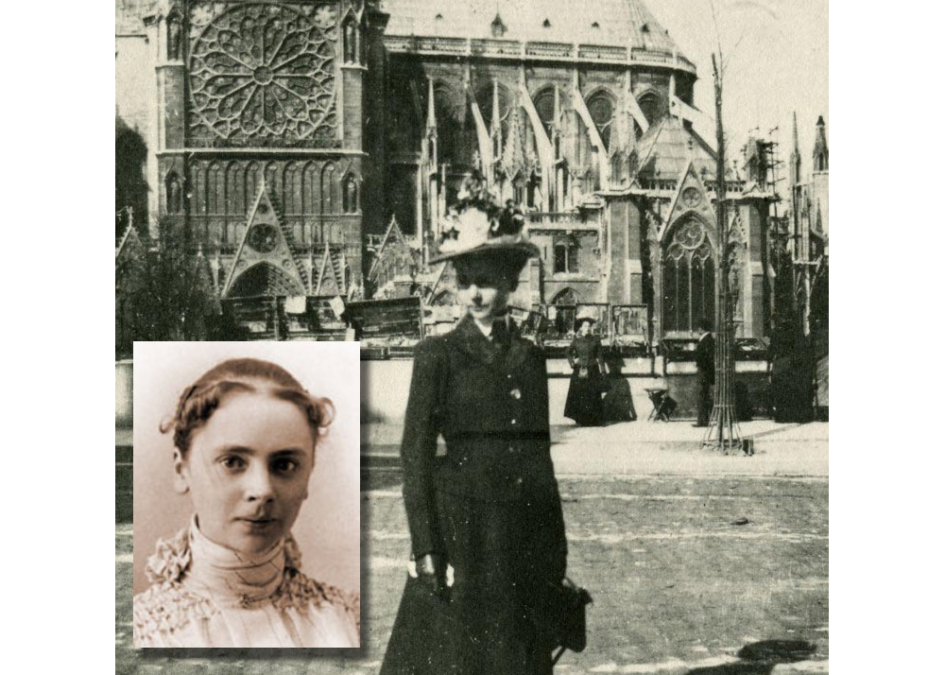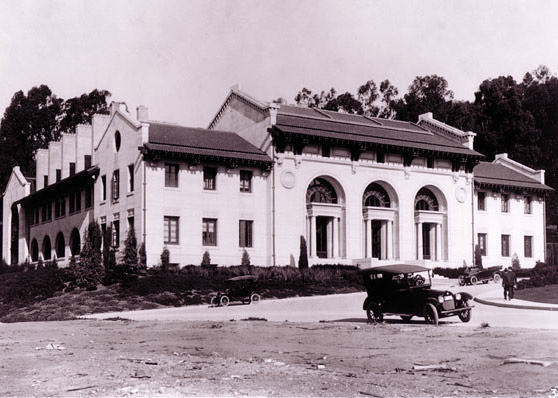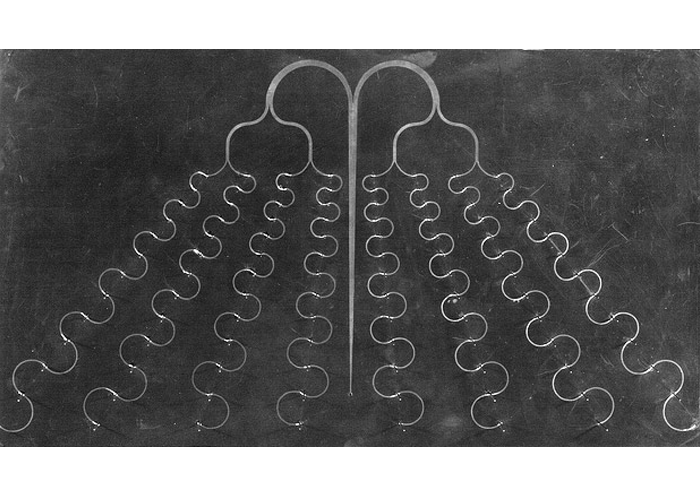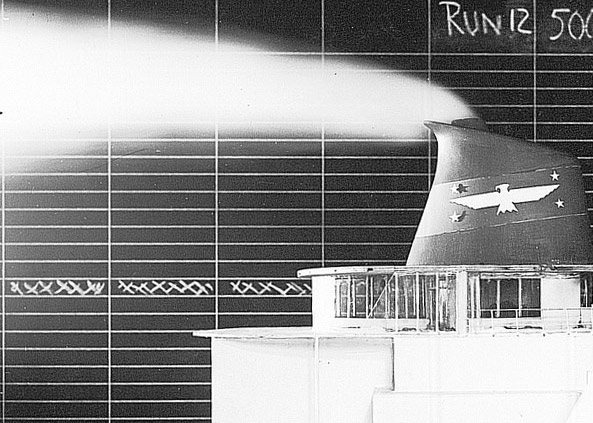Milestones
Earth sciences professors set up the first string of seismographic stations in the Western hemisphere to track earthquake data.
The ten stations in the “California System,” which include sites at Chabot Observatory and Mills College in Oakland, use copies of the Ewing Duplex Pendulum seismograph constructed in San Francisco.
California’s growing economy and industries look to Berkeley engineers for help building the state’s early energy infrastructure.
Clarence L. Cory teaches the first electrical engineering courses at Berkeley to meet California’s growing demand for electricity. San Francisco’s electric street lights are the first in the world, while Los Angeles develops the world’s largest electric street car system.
Julia Morgan, the only woman in her class, graduates with a degree in civil engineering.
While at Berkeley, Morgan finds a mentor in well-known California architect Bernard Maybeck, who teaches technical drawing to engineering students. When Morgan graduates she continues her studies at École des Beaux-Arts in Paris. She is the first woman to study there. Morgan begins her career as an architect in San Francisco and goes on to design more than 700 buildings. In 2014, Morgan is posthumously awarded the Gold Medal from the American Institute of Architects in recognition of her influence on the profession.
Soon after discovery of the X-ray in Germany, a group of young Berkeley engineers hack together cathode ray tubes from the physics department to create their own imaging equipment.
The engineers, led by mechanical engineering professor Joseph Nisbet LeConte, use their new machine to take images of a small boy — another professor’s son, who was accidentally shot in the arm. Using the image, they are able to determine the location of the bullet.
LeConte spent his summers exploring the Sierra Nevada, making maps and naming peaks. Along with John Muir, he was one of the founding members of the Sierra Club and served as the club’s second president.
Increasing energy efficiency and experimenting with emerging technologies become underpinning themes of the college’s research.
Berkeley engineers pioneer high-voltage power transmission technologies, which allow San Francisco and Los Angeles to grow by harnessing hydroelectric power from the Sierra Nevada. Berkeley engineers also develop electric vehicles that can travel 100 miles per charge.
John Galen Howard starts to turn a loose collection of buildings into an iconic university campus.
Howard establishes the architecture department and begins executing the university’s architectural plan. His legacy includes Sather Gate and Sather Tower (the Campanile), Hearst Greek Theatre, California Memorial Stadium and Hearst Memorial Mining Building.
Rube Goldberg graduates from the College of Mining. Goldberg brings engineering concepts and humor to a nationwide audience through his syndicated newspaper cartoons depicting characters using elaborately complicated machines to complete simple tasks.
Goldberg’s drawings earn him numerous awards, but it is the decidedly sober subject of the atom bomb that earns him the Pulitzer Prize in 1948 for editorial cartooning. Today, in honor of his ridiculously complicated contraptions, engineering students across the country compete every year in Rube Goldberg machine-building competitions.
The building, begun in 1902, is completed after an 18-month delay due to the 1906 San Francisco earthquake. Called “the architectural gem of the entire UC system,” Hearst Mining is equipped with small smelters, rock crushers, drill rigs and chemical fume hoods.
The new home for the College of Mining is funded by philanthropist Phoebe Apperson Hearst as a monument to her late husband, U.S. Senator George Hearst. The Beaux Arts building, designed by campus architect John Galen Howard, combines features of classical, Mediterranean and California mission styles, with a grand, three-story lobby crafted to resemble a mine shaft.
Reflecting California’s Gold Rush roots, mining and mineral extraction are popular majors for early Berkeley students.
Mining students practice mining rescue techniques outside the Lawson Adit, a teaching and research mine located in the hill behind Hearst Memorial Mining Building and stretching to the Hayward Fault.
The newly completed Hesse Hall houses the growing college. The building provides space for a motor, generator, radio labs and test rooms.
Hesse Hall is named after Friedrich G. Hesse, who was appointed the first engineering faculty member in 1875. Hesse also served as the first Dean of the College of Mechanics in 1896.
The colleges of Mechanics and Civil Engineering merge to form the College of Engineering, and electrical engineering becomes a department in the new college.
McLaughlin Hall, which serves as the administrative hub for the newly combined college, is completed. The College of Mining joins the college in 1942.
The college plays an important role in the World War II effort, even as male enrollment drops more than 50 percent under the pressures of military enlistment.
As part of the federal Engineering Defense Training program, Berkeley’s Department of Mechanical Engineering lays the groundwork for large-scale industrial training programs in the San Diego, Los Angeles and San Francisco areas. By the time the war ends in 1945, more than 150,000 men and women are trained for industrial occupations by the university.
The breakneck pace of research and innovation during World War II sets a new standard. Industry and government partnerships prove mutually beneficial for the translation of academic research into technologies available to the public.
Berkeley completes $57 million worth of government-sponsored World War II research. Its partnership with the federal government sets the stage for Berkeley becoming a major research university.
Berkeley’s first building to be built in the Modernist style is designed to house the growing electrical engineering department.
The building, named for Clarence L. Cory, dean of the College of Mechanics and a faculty member for almost 40 years, houses a state-of-the-art electronic micro-fabrication facility and labs devoted to integrated circuits, lasers, and robotics. The fifth floor was added in 1985, with an exterior featuring a computer chip-inspired design motif.
The Department of Materials Science and Engineering takes shape.
The merger of the College of Mining with the College of Engineering in 1942 makes resources available to pursue emerging materials science. Walter S. Meeks is the first department chair of the new Department of Mining and Metallurgy. Beyond the existing fields of mining, metallurgy and petroleum engineering, new disciplines are added to the curriculum that reflect California’s changing economy and industry: physical metallurgy (1941), ceramic engineering (1948) and geological engineering (1956). The name is changed to the Department of Mineral Technology in 1948 to more accurately describe the curricular options.
Efficiency in naval architecture research.
Using everything from wind tunnels and handmade wooden ship models to life-size testing on San Francisco Bay, Berkeley’s naval architecture program — one of only four accredited degree programs in the nation — is led by professor John V. Wehausen, a pioneer in the field of marine hydrodynamics.
The growing industrial demand for optimization and management strategies in the booming economic growth of the 1950s leads to the development of the Industrial Engineering Department, which eventually becomes the Department of Industrial Engineering and Operations Research.
Started as a division within the mechanical engineering department, industrial engineering sees rapid growth after World War II as the supply chain and logistics lessons learned during the war are translated into industrial contexts. Professor Paul DeGarmo, known by his students as Mr. E120 for his enthusiastic teaching of the intro engineering economics class, is largely credited with pushing for development of the department.
During the late 1950s, Berkeley engineers begin biomechanical and prosthetic research. Advances in devices and technology translate into improving the quality of life for end users.
Chuck Radcliffe receives his Ph.D. in mechanical engineering from Berkeley. He becomes a faculty member and principal investigator in the Prosthetics Research Group of the Biomechanics Laboratory for the next 35 years. His major projects are the study of human locomotion and improved prosthetic limb design. He makes pioneering contributions to the quadrilateral socket, patellar-tendon-bearing (PTB) prosthesis, solid ankle cushion heel (SACH) foot and the four-bar prosthetic knee. He is credited with providing the fundamental principles of the biomechanics of prosthetic alignment and socket force transfer throughout the amputee gait cycle. He publishes numerous papers on mechanism design, especially as applied to prosthetic devices, and is often lauded as the father of prosthetic biomechanics.
The Department of Nuclear Engineering is founded on the Berkeley campus.
Thomas H. Pigford is the first chair of the department. He calls for a research reactor to be built in the basement of Etcheverry Hall so that students and faculty can run tests and experiments. The department develops a leading reputation in nuclear energy development, radiation detection and management, and medical imaging.
Early research in microelectronics sets the stage for the future growth of the computer and electronic technology industries that become part of California’s economy and identity.
The microelectronics industry that is now vital to California’s economy got its start on the Berkeley and Stanford campuses. Working at the controls in this early Berkeley microelectronics lab (circa 1960) is graduate student David A. Hodges, who later becomes a dean. Labs like this were precursors to the university’s $4 million microfabrication facility, which, when it opens in 1985, becomes the first of its kind on a university campus.
Charles Dalziel, a professor of electrical engineering and computer sciences, invents the ground-fault circuit interrupter, a device now found in virtually every home and building to protect people from electrical shocks caused by defects in appliances or grounding systems.
Dalziel was a pioneer in understanding electric shock in humans, and author of “The Effects of Electric Shock on Man,” which explained the effects of different amounts of electricity on people. The book was based in part on experiments on human subjects, including himself.
Etcheverry Hall opens, housing the departments of mechanical engineering, nuclear engineering and industrial engineering and operations research.
Etcheverry, the first UC-built building on the north side of Hearst Ave., was named for Bernard Etcheverry, professor of drainage and irrigation. It once held a functioning nuclear reactor in its basement and a research wind tunnel, both now dismantled.
Douglas Engelbart, who earned two graduate degrees in electrical engineering at UC Berkeley, outlines the future of the information age in a 90-minute public multimedia demonstration.
After serving as a radar technician in World War II, followed by a brief stint at Ames Research Center, Engelbart came to Berkeley Engineering. He earned a master’s degree in electrical engineering in 1953 and, two years later, a Ph.D., also in EE. In 1964, Engelbart developed an early prototype of a computer mouse using a block of pine. In 1968, in a now famous presentation called “the mother of all demos,” Engelbart outlined the future of the information age and showed the audience his ideas about easily accessible graphic computer interfaces (making use of his mouse), networking and collaborative concepts such as email and shared documents.
UNIX, a computer operating system used worldwide and foundational to the modern internet, is created by two friends who wanted to play a computer game.
Berkeley electrical engineering graduate student Kenneth Thompson and Dennis Ritchie, a scientist at Bell Laboratories, want to play the computer game “Space Travel” on a dusty old mainframe computer. To do it, the two write a new operating system for the machines. The end result is UNIX, still the industry standard operating system, in various flavors, for workstation and networked computing, and a key component in the internet’s infrastructure. (Peter Hamer photo, via Wikimedia Commons)
Cetus, the world’s first biotechnology company, is founded by Donald Glaser, a Berkeley professor and 1960 Nobel Prize winner in physics who later took up the study of molecular biology.
Cetus begins life seeking automated methods to select for industrial microorganisms. Its biggest successes, however, are in pharmaceutical R&D and DNA diagnostics, including creation of the technique of polymerase chain reaction DNA amplification.
A team led by EECS professor Donald Pederson develops the Simulation Program with Integrated Circuit Emphasis (SPICE) — a tool that, along with its derivatives, has been used in the design of almost every integrated circuit since its invention.
SPICE inspired and served as a basis for many other circuit simulation programs in academia, industry and commercial products. Part of the reason for its success is that, in keeping with Berkeley’s core values, it was an early public domain software program with source code available.
The electrical engineering department grows to encompass computer science, officially becoming the Department of Electrical Engineering and Computer Sciences (EECS).
During the early 1960s, computer scientists from Berkeley’s programs were advancing quickly to assume leadership roles in the budding computer systems and information technology-related fields. In 1968, a group of electrical engineering faculty transferred to the College of Letters & Science to create a stand-alone department of computer science. In order to amplify collaboration and research opportunities, the electrical engineering department grew to encompass computer science in 1973.
Graduate student Bill Joy develops Berkeley UNIX and the Berkeley Software Distribution System.
EECS graduate student Bill Joy releases Berkeley UNIX using the name Berkeley Software Distribution. The software is available to anyone who wants it and marks the beginning of the open source movement. (Photo courtesy Sun Microsystems)
WICSE, the student group Women in Computer Science and Engineering, is founded in 1977, and holds its first conference on the Berkeley campus the following year.
The group goes on to support women students and faculty members through conferences, workshops, social events and outreach programs. Today, more than 40 years later, it is one of many programs supporting diversity in the college and seeking to broaden the pipeline for underrepresented populations entering STEM fields.
Construction is completed on the Bechtel Engineering Center, located in the heart of the engineering section of campus.
The building houses the Kresge Library, Sibley Auditorium and the Garbarini Lounge. Today the building is also the headquarters for Engineering Student Services and the Center for Access to Engineering Excellence. The Bechtel Engineering Center is named for benefactor Stephen D. Bechtel. He attended Berkeley Engineering for one year following his service in World War I and before going to work for — and eventually running — Bechtel Corporation, which was started by his father and has since grown into one of the largest construction and civil engineering firms in the country.
EECS professor David Patterson develops the “reduced instruction set computer.”
Patterson directs a project that produces a simpler, cheaper, faster approach to the design of computer central processing units (CPUs). This “reduced instruction set computer” (RISC) makes CPUs more efficient. The invention ultimately garners Patterson and his co-creator, former Stanford president John Hannessey, the 2017 Turing Award, considered the Nobel prize of computing.
The city of Berkeley goes nuclear free, forcing the closure of the research reactor in Etcheverry Hall.
Voters in the city of Berkeley pass the Nuclear Free Berkeley Act, allowing fines for nuclear weapons-related activity. Although the state university is not subject to municipal ordinances, the nuclear engineering department eventually decommissions and dismantles its research reactor in the basement of Etcheverry.
Along with his graduate students, Richard Muller, professor of EECS, produces the first electrically powered, microscopic motor, no larger than the width of a human hair. This micro-machine helps spawn the field of micro-electro-mechanical systems (MEMS).
Muller joins with fellow EECS professor Richard M. White to found the Berkeley Sensor & Actuator Center, which conducts interdisciplinary research on micro- and nanoscale sensors and moving mechanical elements.
Chang-Lin Tien, a longtime member of the mechanical engineering faculty, becomes chancellor of Berkeley.
Tien, who steered the campus through severe budget storms in the 1990s, was also a talented, tireless teacher and a favorite with students. He was an outspoken supporter of equal opportunity in higher education, and was the first Asian American to head a major U.S. research university.
The construction of Soda Hall, which houses computer science research, is complete.
Soda’s classrooms, labs, and offices are designed to encourage informal interactions among CS students and faculty. It includes advanced networking, wireless capabilities and access to computer clusters for shared computing power, storage and services — all unique for its era.
Professor Tom Budinger is the founding chair for Berkeley’s brand-new Department of Bioengineering.
The first new department established by the college in over 40 years, bioengineering brings together the fields of engineering, biology and medicine to harness faculty expertise in synthetic biology, biomaterials, stem cell engineering and more. The department operates joint Ph.D and Master of Translational Medicine programs with UCSF.
The Blum Center for Developing Economies is launched, focusing on studying developing economies and designing sustainable technologies as a strategy to alleviate poverty.
The interdisciplinary center, affiliated with Berkeley Engineering, brings together engineers, scientists and business leaders to focus on pressing development challenges. Programs like development engineering and the Big Ideas@Berkeley contest support students aiming to use technology to have real-world impact.
The new Stanley Hall opens, home to the bioengineering department’s labs, offices and classrooms.
The building, which also houses the California Institute for Quantitative Biosciences (QB3), serves as a hub for interdisciplinary research in math, chemistry, physics and biology, as well as engineering.
Bioengineering professor Dan Fletcher and his students develop the CellScope, a tool capable of turning a smartphone into a diagnostic tool for tuberculosis, malaria and other diseases.
Combining basic hardware with custom software, the CellScope team has enabled mobile microscopy to solve problems around the world, from parasitic worms to ocular diseases to water pollution. Commercialized spinoffs include an otoscope for diagnosing ear infections, part of a planned digital home health kit.
Sutardja Dai Hall opens and becomes the home for the Center for Information Technology Research in the Interest of Society.
Sutardja Dai Hall becomes the new home of the Center for Information Technology Research in the Interest of Society (CITRIS) and the Banatao Institute @ CITRIS Berkeley. CITRIS combines the skills and talents of more than 300 faculty researchers and thousands of students from four UC campuses with industrial partners from more than 60 corporations.
The Coleman Fung Institute for Engineering Leadership enrolls its first master of engineering students.
The Fung Institute trains engineers and scientists in leadership and management while they explore technical concentrations. The MEng program combines leadership coursework and service activities with intensive study in the college’s engineering disciplines.
Austin Whitney and the Berkeley Robotics and Human Engineering Laboratory make history at Berkeley’s commencement ceremony.
Austin Whitney and the Berkeley Robotics and Human Engineering Laboratory, led by mechanical engineer Homayoon Kazerooni, garner national attention after Whitney walks during his Berkeley commencement ceremony using a bionic exoskeleton. Whitney, who is unable to use his legs, worked with a team of Berkeley engineers to get the exoskeleton prototype operational.
A team of Berkeley Engineering faculty, working as part of the campus seismic review committee, advise on the retrofitting of Memorial Stadium, which sits directly astride the Hayward Fault.
The project took years of planning and cost more than $445 million for the stadium upgrades and an additional $153 million to build and integrate a new student-athlete center in the old stadium’s footprint. Today, the Sutardja Center for Entrepreneurship and Technology, as well as other academic programs, are located in the Memorial Stadium complex. California Memorial, designed by John Galen Howard and completed in 1923, sits atop the Hayward Fault, which is still seismically active. The redesigned stadium was put together in four modular parts. The upgrades include gigantic shock absorbers and massive concrete seismic blocks, which allow for the stadium to partially float over the fault, giving some measure of safety in the event of major seismic activity on game day.
Paul Jacobs, EECS alumnus and executive chairman of Qualcomm Inc., takes the stage of the Clinton Global Initiative in June to announce he is donating $20 million to the university to build the Jacobs Institute for Design Innovation.
The new institute provides space and faculty and staff resources to better incorporate design thinking into the engineering curriculum. In studios and workspaces, students learn about and build devices and systems with rapid prototyping and manufacturing technologies. New academic programs, such as a minor in design, will also be part of the institute’s evolution. A new building, Jacobs Hall (opened in 2015), houses the Jacobs Institute.
Berkeley’s first master of translational medicine degree is awarded.
The MTM degree, a collaboration between Berkeley Engineering and UCSF, blends the engineering, clinical and entrepreneurial aspects of translating medical innovation into clinical reality. The intense one-year program provides hands-on experience and real-world projects.
Girls in Engineering launches its first summer program for middle school girls. The program is designed to inspire future engineering leaders by exposing participants to hands-on, team-based projects while emphasizing leadership and engineering in a societal context.
Girls in Engineering is envisioned as one part of the solution to closing the gender gap in science, technology, engineering and math (STEM) fields. Taught by female faculty, staff and students, the program promotes leadership skills and inspires confidence in the participants to pursue STEM fields.
The Management, Entrepreneurship, & Technology Program at the College of Engineering and the Haas School of Business is a fully integrated, simultaneous degree program.
In four years, M.E.T. students can earn a B.S. degree in business from Berkeley-Haas and a B.S. degree in an engineering discipline from Berkeley Engineering while gaining industry experience and practice in entrepreneurship.
A new center focusing on AI and human interactions opens.
Led by EECS professor and artificial intelligence (AI) expert Stuart Russell, the new center opens with a focus on making sure that future AI systems — especially the more complex systems that might control critical infrastructure, or provide people-oriented services — act in a manner that reflects positive human values. EECS professors Pieter Abbeel and Anca Dragan are also co-principal investigators of the new center, which is a collaborative effort across multiple universities.
















































